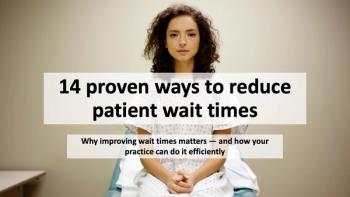
The rule of seven and restarting your business
You’ll have to routinely reach out to patients to get your safety messages to stick.
Have you heard of the marketing rule of seven? I’m guessing you haven’t-and even if you have, you’re probably wondering what it has to do with rebuilding patient volume as the novel coronavirus pandemic evolves.
The rule of seven is a longstanding idea in marketing that a message must be seen at least seven times before a prospect is primed to buy. It takes that many interactions, the theory goes, for a person to remember you and your communication.
It’s a guideline that’s been around for decades. But since it touches on both human psychology and the barrage of media communication, it’s more relevant than ever, given the tsunami information delivered by platforms we visit every day.
So what does this have to do with COVID-19? If you’re like many practices that had to slow down (or even temporarily shut down) in response to the pandemic, the marketing lesson of the rule of seven could be crucial to starting back up effectively.
“Too much” is often not be enough
Most practices we work with at Capko & Morgan are concerned about contacting patients too frequently, except, of course, for the most urgent reasons. Whether it’s the result of people in healthcare being kinder and less sales-oriented, or because physicians themselves get too much annoying email, practices may hold back on communicating about the same things more than once. Yet even in normal times, being too cautious could cause some patients to overlook important non-urgent information.
Consider the structural forces working against your communication efforts. Social media, for example, is great for getting the word out inexpensively. But because of recent algorithm changes, a message posted on your Facebook page is only seen by a fraction of your followers. You will need to rotate that same message through multiple times just to approach one view per person.
Email messages are easily missed, too. Spam filters can be too aggressive. Many patients use Gmail, which automatically sorts mail into categories and may wrongly sort yours as a “promotion.” And regardless of the email system, most of us receive so many emails, it’s easy to miss ones that are not urgent, even when they’re important.
Add these technology problems to the normal challenge of getting a message into a busy patient’s consciousness, and it’s easy to see you’re probably not communicating enough-and that’s before even considering the extra challenge the pandemic presents.
Confusion reigns
Remember that your task of encouraging patients to resume regular visits to your office may be hampered by public health advice that is in flux. Some patients may be afraid to come to the office simply because they aren’t sure they understand their risk of COVID-19 infection, or how to weigh it.
The trust you’ve established with your patients can help you help them break through the clutter of confusing messages and rules. The need to clarify or explain expert information that changes on the fly also provides a reason and opportunity to reach out to patients more frequently.
Use multiple platforms, multiple times-and the personal touch
One easy way to boost the signal of your messages is to share them on multiple platforms. Technology can help. For example, if your website is set up in Wordpress, plugins can automatically share your blog posts on social media. (And even if not, your web developer may be able to automate cross-posting using a protocol called RSS.)
Facebook enables the scheduling of future posts. Set up important information to post multiple times and reach more followers.
Your newsletter platform also likely enables “view this message in a browser.” Sharing that link on your Facebook page and website is another way to get multiple views (and more use) out of your newsletter.
Of course, nothing beats the personal touch for encouraging patients to take better care of themselves. All of the general messages sent to all patients via newsletters, your website, and social media can be accompanied by direct phone and/or your portal outreach to individual patients. Nothing more effectively communicates that you and your practice are concerned for a patient’s well-being.
Spotlight the things that matter most
When reaching out to patients, keep the focus on the things that will help them feel comfortable getting back on track.
For example, explain all the steps your practice has taken to keep patients safe. If you’ve added technology for telemedicine or the ability to schedule appointments or pay online, share how these innovations add convenience and help reduce the risk of germs spreading in your office.
Remember that patients may need to be told about your safety measures multiple times, simply because they’re worried. Fearful patients may have trouble hearing what you’re saying the first time.
In their focus on the coronavirus, patients may also forget other threats to their health. For example, they may delay follow-up care, vaccinations, or preventive screenings. Help them put these needs in context and prioritize.
And if some of your patients have been laid off or furloughed, they may have had to switch health plans or be stressed about finances. Patients may skip preventive care or follow-up visits because they don’t realize those services don’t require out-of-pocket costs. Be sure staff is prepared to explain these differences to patients during outreach, to avoid an unnecessary fear causing some patients to delay care.
About the Author
Newsletter
Optimize your practice with the Physicians Practice newsletter, offering management pearls, leadership tips, and business strategies tailored for practice administrators and physicians of any specialty.








